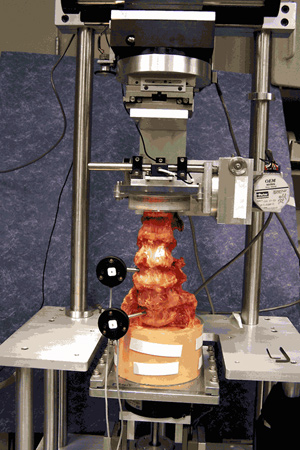Stress Profiles of the Lumbar Intervertebral Disc During Flexion and Extension

Figure 1: Custom designed testing apparatus.
Principal Investigator: Ralph Gay, M.D.
Project Coordinator: Lawrence J. Berglund — berglund.lawrence@mayo.edu
Knowledge of lumbar intervertebral disc (IVD) biomechanics is central to understanding the genesis of low back and leg pain caused by disc dysfunction or herniation. Many non-surgical treatments for low back disorders are based on the theoretical effects of either flexion or extension on disc behavior. Distraction manipulation, a treatment method commonly used by chiropractors, and physical therapists, is thought to reduce intradiscal pressure and cause a shift of the nucleus pulposus. Although preliminary cadaveric studies have shown that it can reduce nucleus pressure, its effect on stress distribution and the resulting position of the nucleus pulposus within the disc is unknown. The primary objective of this study was to determine the effect of distraction alone and distraction combined with flexion or extension on the distribution of intradiscal pressure and stress in normal and degenerative cadaveric lumbar discs (Fig. 1). This was accomplished by using the technique of stress profilometry to map changes in stress distribution within the IVD during simulated flexion-distraction treatment of cadaveric motion segments from L2- 3 to L5-S1. The patterns of stress distribution observed from this study, whether supportive of current theory or not, will be used to generate new hypotheses and design more effective non-surgical treatment strategies for disc related spinal conditions. Eighteen specimens have been tested and graded with data analysis ongoing.